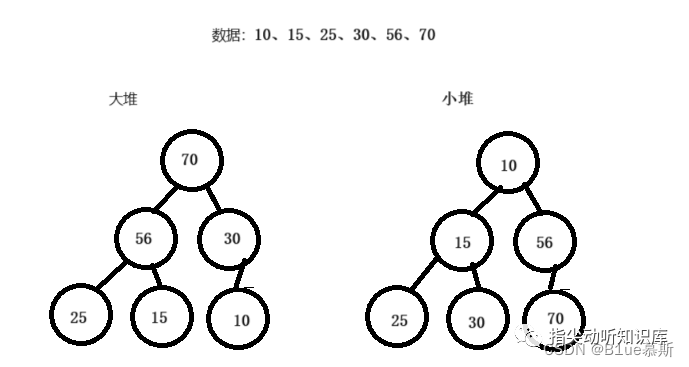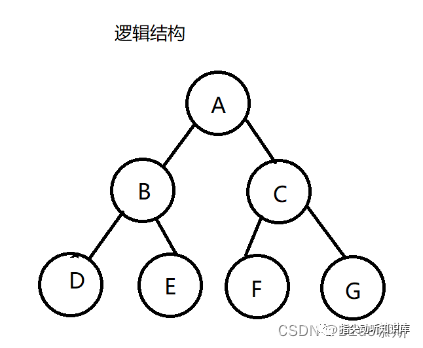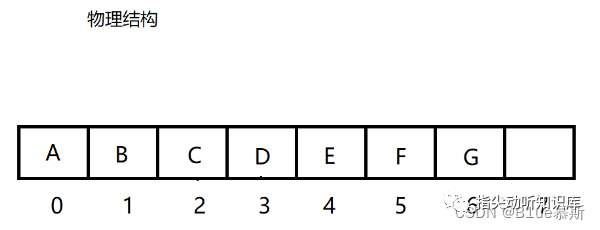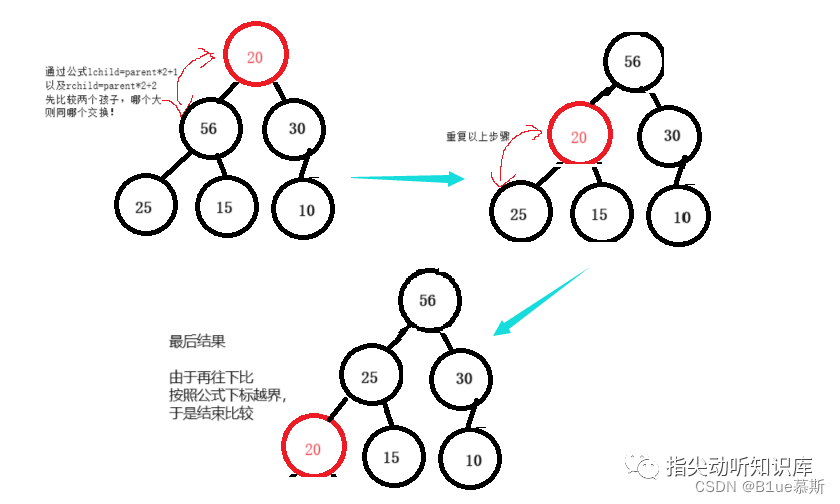

堆的实现思路
描述
什么是堆?
- 堆是一种 基于树结构的数据结构,它是一棵二叉树 ,具有以下两个特点:
- 堆是一个完全二叉树,即除了最后一层,其他层都是满的,最后一层从左到右填满。
- 堆中每个节点都满足堆的特性,即父节点的值要么等于或者大于(小于)子节点的值。
1.1 堆的分类
堆一般分为两类: 大堆和小堆 。
- 大堆中,父节点的值大于或等于子节点的值,
- 小堆中,父节点的值小于或等于子节点的值。
堆的主要应用是在排序和优先队列中。
以下分别为两个堆(左大堆,右小堆):

Part2 堆的实现思路
2.1 使用什么实现?

逻辑结构如上, 然而这仅仅是我们想像出来的而已,而实际上的堆的物理结构是一个完全二叉树 , 通常是 用数组实现的 。如下:

对此,这就要引申出一个问题?我们该如何分辨父节点以及子节点呢?如下:
2.2 怎么分辨父节点以及子节点?
通常我们的数组下标为“0”处即为根节点,也就是说我们一定知道一个父节点!并且我们也有“计算公式”来计算父节点以及子节点。(先记住,后面实现有用!!!)也就是说我们也可以通过公式从每一个位置计算父节点以及子节点!如下:



2.3 总体实现思路
先建立一个结构体,由于堆的结构实际上是一颗完全二叉树,因此我们的 结构跟二叉树一样即可! 接着,想想我们的堆需要实现的功能? 构建、销毁、插入、删除、取堆顶的数据、取数据个数、判空 。(⊙o⊙)…基本的就这些吧哈~
接着按照 定义函数接口->实现各个函数功能->测试测试->收工(-_^) o(  ̄▽ ̄ )ブ
Part3** 堆的实现**
3.1 结构体以及接口的实现
typedefint HPDataType;
typedefstruct Heap
{
HPDataType* _a;
int _size;
int _capacity;
}Heap;
// 堆的构建
void HeapCreate(Heap* hp, HPDataType* a, int n);
// 堆的销毁
void HeapDestory(Heap* hp);
// 堆的插入
void HeapPush(Heap* hp, HPDataType x);
// 堆的删除
void HeapPop(Heap* hp);
// 取堆顶的数据
HPDataType HeapTop(Heap* hp);
// 堆的数据个数
int HeapSize(Heap* hp);
// 堆的判空
int HeapEmpty(Heap* hp);
3.2 堆的两种建堆方式
在实现以上的接口之前,我们必须要知道堆的两种建堆方式!!!
并且仅仅通过调整建堆方式的<和>符号,我们就可以轻易控制大小堆,具体看代码注释!
建堆有两种方式,分别是 自底向上建堆以及自顶向下建堆。 具体简介如下:
- 自底向上建堆:自底向上建堆是指按照原始数组顺序依次插入元素,然后对每个插入的元素执行向上调整的操作,使得堆的性质保持不变。这种方法需要对每个元素都进行调整操作,时间复杂度为 O(nlogn)。
- 自顶向下建堆:自顶向下建堆是指从堆顶开始,对每个节点执行向下调整操作,使得堆的性质保持不变。这种方法需要从根节点开始递归向下调整,时间复杂度为 O(n)。因此,自顶向下建堆的效率比自底向上建堆要高。
以上两种建堆方式,实际上是基于两种调整方法,接下来将详细介绍:
向上调整方法
堆的向上调整方法将新插入的节点从下往上逐层比较,如果当前节点比其父节点大(或小,根据是大根堆还是小根堆),则交换这两个节点。一直向上比较,直到不需要交换为止。这样可以保证堆的性质不变。
具体步骤如下:
- 将新插入的节点插入到堆的最后一位。
- 获取该节点的父节点的位置,比较该节点与其父节点的大小关系。
- 如果该节点比其父节点大(或小,根据是大根堆还是小根堆),则交换这两个节点。
- 重复步骤2-3,直到不需要交换为止,堆的向上调整完成。
- 堆的向上调整的时间复杂度为O(logn),其中n为堆的大小。
一图让你了解~:

实现如下:
void swap(HPDataType* s1, HPDataType* s2)
{
HPDataType temp = *s1;
*s1 = *s2;
*s2 = temp;
}
void Adjustup(HPDataType* a, int child)//向上调整
{
int parent = (child - 1) / 2;
while (child > 0)
{
if (a[child] > a[parent])//建大堆,小堆则<
{
swap(&a[child], &a[parent]);
child = parent;
parent = (child - 1) / 2;
}
else
{
break;
}
}
}
向下调整方法
堆的向下调整方法是指将某个节点的值下放至其子节点中,以维护堆的性质的过程。
假设当前节点为 i,其左子节点为 2i+1,右子节点为 2i+2,堆的大小为 n
则向下调整的步骤如下:
- 从当前节点 i 开始,将其与其左右子节点中较小或较大的节点比较,找出其中最小或最大的节点 j。
- 如果节点 i 小于等于(或大于等于,取决于是最小堆还是最大堆)节点 j,则说明它已经满足堆的性质,调整结束;否则,将节点 i 与节点 j 交换位置,并将当前节点 i 更新为 j。
- 重复执行步骤 1 和步骤 2,直到节点 i 没有子节点或已经满足堆的性质。
一图让你了解~:

实现如下:
void swap(HPDataType* s1, HPDataType* s2)
{
HPDataType temp = *s1;
*s1 = *s2;
*s2 = temp;
}
void Adjustdown(HPDataType* a, int n, int parent)//向下调整
{
int child = parent * 2 + 1;
while (child < n)
{
if (child + 1 < n && a[child + 1] > a[child])//找出两个孩子中较大的那个,此为大堆,如果要实现小堆则 改 >
{
++child;
}
if (a[child] > a[parent])//此为大堆,如果要实现小堆则 改 >
{
swap(&a[child], &a[parent]);
parent = child;
child = parent * 2 + 1;
}
else
{
break;
}
}
}
3.3 堆的构建
void HeapCreate(Heap* hp, HPDataType* a, int n)
{
assert(hp);
assert(a);
hp- >_a = (HPDataType*)malloc(sizeof(HPDataType) * n);
if (!hp- >_a)
{
perror("malloc fail");
exit(-1);
}
hp- >_capacity = hp- >_size = n;
//将a中的元素全部转移到堆中
memcpy(hp- >_a, a, sizeof(HPDataType) * n);
//建堆
for (int i = 1; i < n; i++)
{
Adjustup(hp- >_a, i);//按向上调整,此建立大堆
}
}
本文的构建方法是 通过传递一个数组以及传递一个数组大小来构建的 ,里面包括了堆结构体的初始化操作,基本的建堆方式则是通过向上调整方法建堆。
3.4 堆的销毁
void HeapDestory(Heap* hp)
{
assert(hp);
free(hp- >_a);
hp- >_a = NULL;
hp- >_capacity = hp- >_size = 0;
}
就正常的销毁操作?大家应该都懂(确信) (o°ω°o)
3.5 堆的插入
void HeapPush(Heap* hp, HPDataType x)
{
assert(hp);
if (hp- >_capacity == hp- >_size)//扩容
{
int newcapacity = hp- >_capacity == 0 ? 4 : hp- >_capacity * 2;
HPDataType* new = (HPDataType*)realloc(hp- >_a, sizeof(HPDataType) * newcapacity);
if (!new)
{
perror("realloc fail");
exit(-1);
}
hp- >_a = new;
hp- >_capacity = newcapacity;
}
hp- >_a[hp- >_size++] = x;
Adjustup(hp- >_a, hp- >_size - 1);
}
实现是对于堆的空间进行判断,不够则是扩容操作,当然也有初始化的意思,接着是通过向上调整的方式插入操作。
3.6 堆的删除(较重要)
void HeapPop(Heap* hp)//先将最后一个数与堆顶交换,然后再让size--,再进行向下调整
{
assert(hp);
swap(&hp- >_a[0], &hp- >_a[hp- >_size - 1]);
hp- >_size--;
Adjustdown(hp- >_a, hp- >_size, 0);
}
进行删除操作,我们当然是删除堆顶啦,这个删除操作先将最后一个数与堆顶交换,然后再让size--,再进行向下调整。
一图让你了解~:

3.7 取堆顶的数据
HPDataType HeapTop(Heap* hp)//取堆顶
{
assert(hp);
assert(hp- >_size > 0);
return hp- >_a[0];
}
3.8 堆的数据个数
int HeapSize(Heap* hp)//堆大小
{
assert(hp);
return hp- >_size;
}
3.9 堆的判空
int HeapEmpty(Heap* hp)//判堆空
{
assert(hp);
return hp- >_size==0;
}
Part4 总体代码
4.1pile.h
#pragma once
#define _CRT_SECURE_NO_WARNINGS 01
#include< stdio.h >
#include< stdlib.h >
#include< string.h >
#include< assert.h >
typedefint HPDataType;
typedefstruct Heap
{
HPDataType* _a;
int _size;
int _capacity;
}Heap;
// 堆的构建
void HeapCreate(Heap* hp, HPDataType* a, int n);
// 堆的销毁
void HeapDestory(Heap* hp);
// 堆的插入
void HeapPush(Heap* hp, HPDataType x);
// 堆的删除
void HeapPop(Heap* hp);
// 取堆顶的数据
HPDataType HeapTop(Heap* hp);
// 堆的数据个数
int HeapSize(Heap* hp);
// 堆的判空
int HeapEmpty(Heap* hp);
4.2pile.c
#include"pile.h"
void swap(HPDataType* s1, HPDataType* s2)
{
HPDataType temp = *s1;
*s1 = *s2;
*s2 = temp;
}
void Adjustup(HPDataType* a, int child)//向上调整
{
int parent = (child - 1) / 2;
while (child > 0)
{
if (a[child] > a[parent])//建大堆,小堆则<
{
swap(&a[child], &a[parent]);
child = parent;
parent = (child - 1) / 2;
}
else
{
break;
}
}
}
void Adjustdown(HPDataType* a, int n, int parent)//向下调整
{
int child = parent * 2 + 1;
while (child < n)
{
if (child + 1 < n && a[child + 1] > a[child])//找出两个孩子中较大的那个,此为大堆,如果要实现小堆则 改 >
{
++child;
}
if (a[child] > a[parent])//此为大堆,如果要实现小堆则 改 >
{
swap(&a[child], &a[parent]);
parent = child;
child = parent * 2 + 1;
}
else
{
break;
}
}
}
void HeapCreate(Heap* hp, HPDataType* a, int n)
{
assert(hp);
assert(a);
hp- >_a = (HPDataType*)malloc(sizeof(HPDataType) * n);
if (!hp- >_a)
{
perror("malloc fail");
exit(-1);
}
hp- >_capacity = hp- >_size = n;
//将a中的元素全部转移到堆中
memcpy(hp- >_a, a, sizeof(HPDataType) * n);
//建堆
for (int i = 1; i < n; i++)
{
Adjustup(hp- >_a, i);//按向上调整,此建立大堆
}
}
void HeapDestory(Heap* hp)
{
assert(hp);
free(hp- >_a);
hp- >_a = NULL;
hp- >_capacity = hp- >_size = 0;
}
void HeapPush(Heap* hp, HPDataType x)
{
assert(hp);
if (hp- >_capacity == hp- >_size)//扩容
{
int newcapacity = hp- >_capacity == 0 ? 4 : hp- >_capacity * 2;
HPDataType* new = (HPDataType*)realloc(hp- >_a, sizeof(HPDataType) * newcapacity);
if (!new)
{
perror("realloc fail");
exit(-1);
}
hp- >_a = new;
hp- >_capacity = newcapacity;
}
hp- >_a[hp- >_size++] = x;
Adjustup(hp- >_a, hp- >_size - 1);
}
void HeapPop(Heap* hp)//先将最后一个数与堆顶交换,然后再让size--,再进行向下调整
{
assert(hp);
swap(&hp- >_a[0], &hp- >_a[hp- >_size - 1]);
hp- >_size--;
Adjustdown(hp- >_a, hp- >_size, 0);
}
HPDataType HeapTop(Heap* hp)//取堆顶
{
assert(hp);
assert(hp- >_size > 0);
return hp- >_a[0];
}
int HeapSize(Heap* hp)//堆大小
{
assert(hp);
return hp- >_size;
}
int HeapEmpty(Heap* hp)//判堆空
{
assert(hp);
return hp- >_size==0;
}
4.3test.c
#include"pile.h"
void test()
{
Heap hp;
int arr[] = { 1,6,2,3,4,7,5 };
HeapCreate(&hp, arr, sizeof(arr) / sizeof(arr[0]));
//HeapPush(&hp, 10);
printf("%dn", HeapSize(&hp));
while (!HeapEmpty(&hp))
{
printf("%d %d n", HeapTop(&hp), HeapSize(&hp));
HeapPop(&hp);
}
printf("%dn", HeapSize(&hp));
HeapDestory(&hp);
HeapSort(arr, sizeof(arr) / sizeof(arr[0]));
printf("n");
}
int main()
{
test();
return0;
}
4.4 测试结果

-
怎样自动实现把一堆东西一个一个挪到另一个位置?2016-04-06 3887
-
iOS如何抽奖轮盘效果实现思路2020-04-28 1982
-
串口WiFi模块实现远程控制电饭煲的设计思路分享.pdf2018-04-26 1957
-
实现完全 MCU 分区隔离:堆2021-11-26 488
-
UVC bulk传输实现思路2023-09-25 7320
全部0条评论

快来发表一下你的评论吧 !

